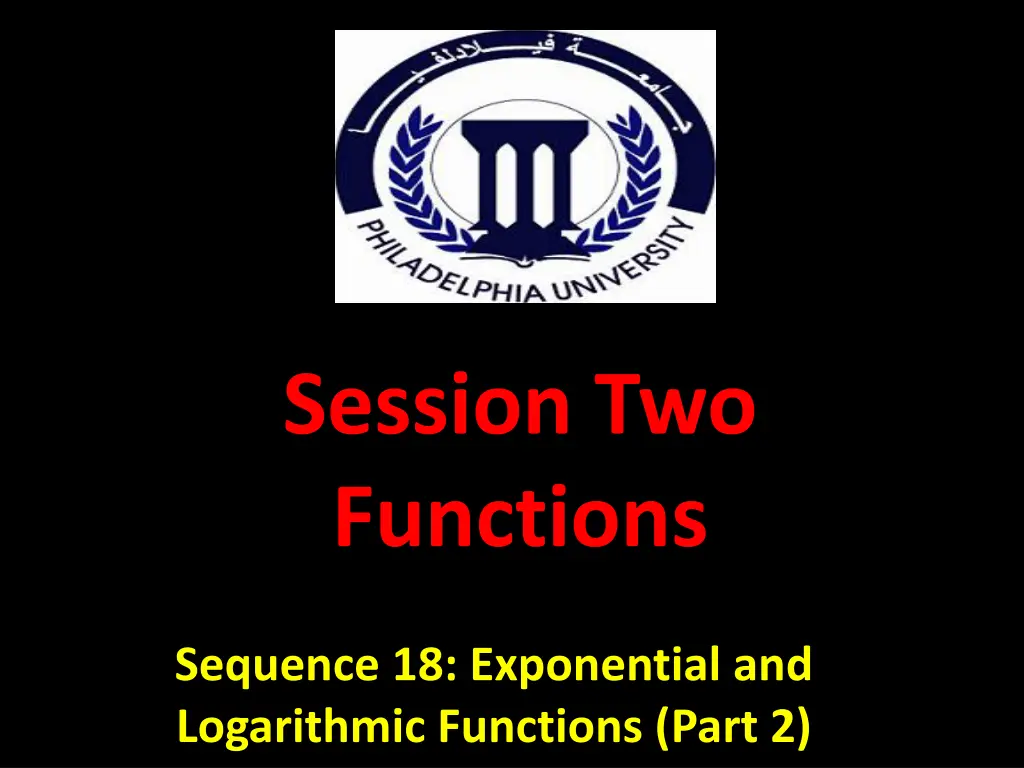
Understanding Exponential and Logarithmic Functions
Explore the concepts of exponential and logarithmic functions, including the natural logarithmic function and properties of logarithms. Learn how to solve equations involving these functions using one-to-one and inverse properties. Dive into examples and solutions to deepen your understanding.
Download Presentation

Please find below an Image/Link to download the presentation.
The content on the website is provided AS IS for your information and personal use only. It may not be sold, licensed, or shared on other websites without obtaining consent from the author. If you encounter any issues during the download, it is possible that the publisher has removed the file from their server.
You are allowed to download the files provided on this website for personal or commercial use, subject to the condition that they are used lawfully. All files are the property of their respective owners.
The content on the website is provided AS IS for your information and personal use only. It may not be sold, licensed, or shared on other websites without obtaining consent from the author.
E N D
Presentation Transcript
Session Two Functions Sequence 18: Exponential and Logarithmic Functions (Part 2)
Sequence 18: Exponential and Logarithmic Functions (Part 2) The Natural logarithmic Function: By looking back to the natural exponential function ? ? = ??,you will see it is one-to-one and so has an inverse function. This inverse function is called the natural logarithmic function and is denoted by the special symbol ln? , read as: the natural log of ? . Definition: For ? > ?,? = ln? if and only if ? = ??. The function given by ? ? = log?? = ln? is called the natural logarithmic function. The domain of the natural logarithmic function ? ? = ln?(?) is ? :? ? > ? ??? ?????? ?? ?(?)
Sequence 18: Exponential and Logarithmic Functions (Part 2) From the previous definition, you can see that every logarithmic equation can be written in an equivalent exponential form and every exponential equation can be written in logarithmic form. The properties of logarithms previously listed are also valid for natural logarithms. 1. 1. ln? = ? ??????? ??= ? 2. 2. ln? = ? ??????? ??= ? 3. 3. ln??= ?ln? 4. 4. ????= ? ??? ?ln ?= ? ?.ln? ? = ln? + ln? ?.ln? ? = ln? ln? ?.?? ln? = ln? ???? ? = ? ?.log?? = ln?/ln?
Sequence 18: Exponential and Logarithmic Functions (Part 2) Now, you will study procedures for solving equations involving exponential and logarithmic functions. There are two basic strategies for solving exponential or logarithmic equations. The first is based on the One-to-One Properties and the second is based on the Inverse Properties. 1. One-to-One Properties:??= ??if and only if ? = ? , and log?? = log?? if and only if ? = ? . 2. Inverse Properties:?log??= ? and log???= ? .
Sequence 18: Exponential and Logarithmic Functions (Part 2) Example: Solve the following equations. 1. 1. ??= ?? 2. 2. ln? = ? Solution: 1. 1. ??= ?? ??= ?? ? = ? by one-to-one property. 2. 2. ln? = ? ?ln ?= ? ? ? = ? ?by inverse property. Example: Solve the equation ?? ????= ?. Solution: ?? ????= ? ??? ?? = ? ? ?? = ? ?? ?? ? ?
Sequence 18: Exponential and Logarithmic Functions (Part 2) Example: Solve the equation log??? = ? . ? ? log?? ? = ? ? ? log??? ? ?log??? ? log??? = ? ??log???= ??? ? = ?? Example: Solve the inequality ? log?? < ?. Solution: ? log?? < ? ?? ?log??< ? ? ? < ? ? [?,?) ? ? log?? ? Solution: log??? ? ?= ? log??? ?log??? = ?
Sequence 18: Exponential and Logarithmic Functions (Part 2) Example: Solve the equation ln? ? + ln?? ? = ?ln? Solution: ln? ? + ln?? ? = ?ln? ln ? ? ?? ? ? ? ?? ? = ?? ??? ?? + ? = ?? ?? ?? + ? = ? ? ? ? ? = ? ? ? = ? ? = ? ? ? = ? ? = ? You can conclude that ? = ? is not valid. This is because when ? = ?, ln(? 2) + ln(?? ? = ln( ?) + ln( ?) , which is invalid because ? is not in the domain of the natural logarithmic function. So, the only solution is ? = ? . = ln?2
Sequence 18: Exponential and Logarithmic Functions (Part 2) Example: Find the domain of ? = ? ?. Solution: ??? ?????? ?? ? ?= ??? ?????? ?? ? = ? :? ? ??? ?????? ?? ? = ?, = ?, . Example: Find the domain of ? ? = ln?2. Solution: ??? ?????? ?? ??? = ? :??> ? ??? ?????? ?? ?? = ? = {?} Do NOT use the properties of logarithms in evaluating the domain of functions.
Sequence 18: Exponential and Logarithmic Functions (Part 2) Example: Find a formula for the inverse of the function ? ? = ??? ?. Solution: First, let ? = ??? ?. By inverse property we have ln? = ln?2? 1and then ln? = ??? ?. So, ? = (? + ln?)/?. Hence,? ?? = (? + ln?)/? . Example: Find a formula for the inverse of the function ? ? = ln(? + ?). Solution: Let ? = ln(? + ?) . By inverse property we have ??= ?ln(?+?)and then ??= ? + ? . So, ? = ?? ?. Hence, ? ?? = (?? ?)
